Airports. At their worst – which is usually – they are noisy, frustrating and stressful. From my recent experience, Kathmandu airport in Nepal is particularly crowded, hot, confusing and uncomfortable, but it is so-called first-world countries that have the most to be ashamed of. Arriving at London Heathrow’s Terminal 4, with its grubby interiors, grumpy staff, long queues, unreliable technology, clunky baggage system and an almost total lack of windows, is to be dreaded. Though more aesthetically pleasing, the Foster + Partners-designed Stansted Airport, north of London, isn’t much better – the amount of glass used means that on sunny days, the arrivals hall is boiling hot, and the queue at immigration akin to a cattle market.
It’s not just big airports that are unpleasant; all over the world, a lack of consideration for the passenger is borne out in poor design and services. An airport is an experience to get through rather than savour. Providenciales International Airport, the main gateway to the spectacularly beautiful Turks & Caicos islands in the Caribbean, is noisy and crowded almost to the point of torture: constant loud announcements, bad, overpriced food, regular flight delays, uncomfortable seating and terrible Wi-Fi. A fast way to forget your idyllic holiday.
Yet it doesn’t have to be like this. At their best, airports complement the inherent promise and excitement of travel by providing a protective bubble, a third dimension distinct from your place of departure and the reality of arrival; away from past and future. They are both portals and a destination unto themselves – rarified, anonymous, dignified and self-affirming.
Zurich Airport, designed by transport hub specialists Grimshaw, is a personal favourite. A cool, calm, quiet, cocoon of slate grey, it feels both protective and flexible, flowing between futuristic tunnel-like concourses and soaring atriums, with natural light but no glare. An integrated rail system takes you smoothly to any destination in Switzerland.
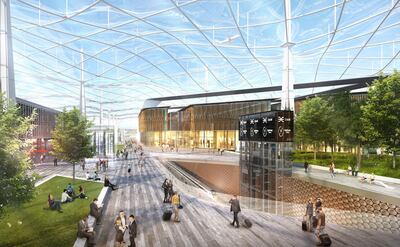
The good news is that countries are finally beginning to realise the importance of investing in their airports. Not only does it degrade or enhance the image of a place, but passengers are more likely to spend time and money in pleasant, stress-free environments. Spending on airport infrastructure has never been greater, and this coincides with big advances in technology and sustainable building. Currently there are a record number of large-scale projects underway around the world, with Asia and the Middle East leading the way.
In the GCC, a much needed new terminal at Muscat International Airport, boosting capacity to 20 million passengers annually, is 97 per cent complete and due to be operational by the end of this year. In Kuwait, construction started this year on a new terminal capable of handling approximately 25m passengers a year. And in Abu Dhabi and Dubai, the new Midfield Terminal, due to open in 2019, and the ongoing expansion of Dubai World Central to an eventual capacity of 240m a year, means that the UAE will continue to be the centre of the global aviation world.
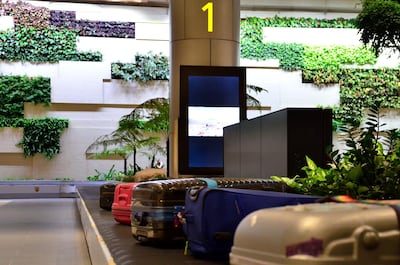
Changi Airport in Singapore, which has set the passenger-experience standard for the past 15 years with its zen-like atmosphere, access to open spaces, range of facilities and use of greenery, last week unveiled T4, a new “boutique terminal” serving 16m passengers a year, to add to the 60m already hosted. With the use of advanced facial recognition software, it offers a fully-automated process at each stage of departure – check-in, bag drop, immigration and boarding. Enhanced 3-D baggage screening means laptops and other items don’t need to be removed from their bags. With so much time saved, the rest of the passenger’s time can be devoted to what the airport calls a “theatre of experience”, including art, shopping and dining. Though it is the size of 27 football fields, passengers will never be more than 100 metres from a toilet, and will have a choice of 80 shops and restaurants.
____________________
READ MORE:
London airports descend into 'chaos" as British Airways' systems go down
Abu Dhabi’s 10 biggest projects nearing completion
Tenders set to be issued for Abu Dhabi’s Midfield Terminal project
____________________
Istanbul New Airport, which will be one of the biggest airports in the world when the fourth and final phase is finished by 2028, will have six runways serving 350 destinations and a capacity of 200m passengers a year. When phase one is finished at the end of next year, the airport will have the world’s largest terminal under one roof, with a floor area of well over a million square metres and a capacity of 90m passengers a year.
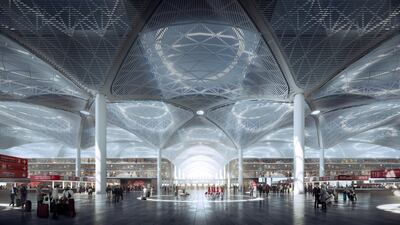
Istanbul’s Ataturk Airport, which is the biggest in Turkey currently, is generally unpleasant to travel through, with noisy, crowded spaces, long walking distances and poor air conditioning.
The size of many airports is relative to the number of flights they serve and therefore unavoidable, according to Jolyon Brewis, a partner in the London-based global architecture, planning and industrial design firm Grimshaw, which designed Zurich Airport and Pulkovo airport in St Petersburg, and is the concept architect of Istanbul New Airport. It is also designing the next phase of Heathrow’s expansion, following recent government approval for a new runway. “Airports are grand in size due to the fact that planes need a lot of space to park, take off and land,” says Brewis. “Until we see a revolutionary change in aircraft design, I don’t think airports will get any smaller. As architects we need to think of ways to make the journey through the airport as enjoyable and intuitive as possible,” he adds.
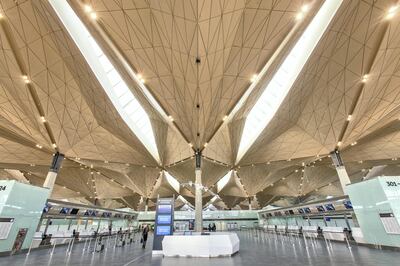
With sustainability now central to all Grimshaw’s projects, Brewis says that the company aims to make Heathrow’s new terminal a benchmark for green aviation. Yet the most important thing design-wise, he says, is for an airport to reflect the city it serves. “Passengers expect to arrive and immediately feel immersed in the local environment. Second only to design and functionality is connectivity to the area it serves. It’s absolutely vital that it is well connected to existing transport infrastructure, offering passengers a variety of enjoyable ways to travel to and from the airport.”
When it comes to the experience itself, an airport is ideally somewhere that people should want to spend time in, with quality entertainment and retail offerings in comfortable surroundings, Brewis adds. “The best airport experience utilises technology in ways that make the passenger’s journey efficient and stress-free. Easy navigation is highly under-rated in terms of creating this ideal environment; airports in a way can act as a hotbed for innovative wayfinding systems and digital signage, which if successful, can be extrapolated to influence urban design on a wider scale, drawing parallels with traversing an airport and traversing a city.”
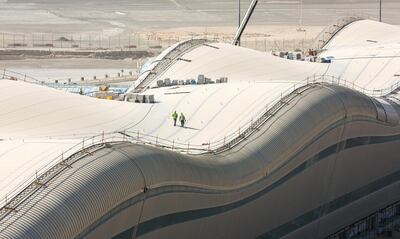
Abu Dhabi’s new Dh19.1 billion Midfield Terminal, which will have 65 gates, will increase annual passenger numbers to over 45m a year, and will do all of the above, according to its American architects Kohn Pedersen Fox (KPF). “The terminal will serve as the new gateway to Abu Dhabi, one of the world’s major transportation hubs and tourist destinations. The design reflects and enhances the excitement of arriving in the city. Additionally, with a high rate of transferring passengers, the project is designed to create a memorable experience of Abu Dhabi, the city, even for travellers who will never set foot outside the airport,” says Mustafa Chehabeddine, the design principal at KPF who is overseeing the new terminal. “For this experience to be genuine, the airport needed to embody the ethos of Abu Dhabi, a forward-looking city embracing innovation and technology and contemporary art and architecture, but also a city rooted in a rich heritage and a spectacular natural setting,” Chehabeddine adds.
Thus, the new terminal is designed with long-span arches supporting a roof that reaches a height of 52m, with a floor-to-ceiling curtainwall allowing visual connectivity between the outdoor landscaping and indoor spaces.
“The form of the roof echoes the undulating silhouette of the desert dunes, while the use of rich, calligraphy-inspired patterns give the main spaces a unique identity. An integrated program of exterior and interior landscape reflects the Garden City,” he says.
Built over six levels, the building will include a hotel, shops, restaurants and an art gallery, which KPF says will share part of the diverse cultural program the city has embraced in the form of new museums such as the Louvre Abu Dhabi. The greatest challenge, he says, has been “to create a building that is at once civic-minded and beautiful, yet efficient”.
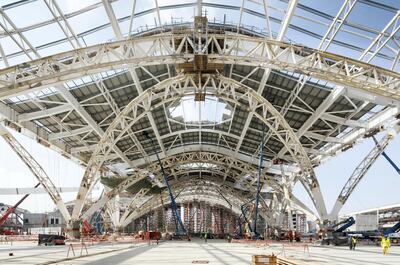
Along with the most advanced technology available, including a baggage handling system with 28km of belt handling 19,200 bags an hour, the Midfield Terminal will also influence the future of airport design, says Chehabeddine, a graduate of the American University of Beirut and the Architecture Association in the United Kingdom. “The traditional view of airports as processing machines is giving way to the importance of the passenger experience. Long queues in generic spaces are being replaced with more efficient check-in and security processes in friendlier, leisure-oriented environments.”
Of the 742,000 square metres of space, the new terminal will have 28,000sq m of shops and restaurants and 30,000sq m of executive lounges. “At the Midfield Terminal, the typical, often oppressive airport retail experience is replaced with a more enjoyable, city-like public square complete with gardens, museums and spas, as well as a hotel. The experience is designed to reduce the level of stress for passengers and replace it with a strong sense of place and excitement.”
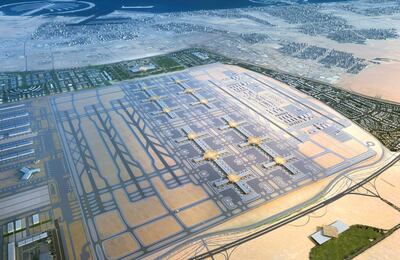
Dubai World Central, which, true to its name, aims to be the world’s biggest airport with a final capacity of over 240m passengers a year, is currently in an eight-year expansion phase intended to make it “the region’s first integrated, multi-modal transportation platform connecting air, sea and land”. The Dh120bn, two-terminal, 56-square-kilometre project will have five parallel runways 4.5km in length, with 800m spacing between each one, which means they can be used simultaneously. “More than its size, the new airport’s uniqueness lies in a radically new approach to ensure that latest technology and efficient processes will cut the time spent completing travel formalities and reduce walking distances, enabling passengers to make fast and efficient connections between hundreds of destinations worldwide.”
New technologies at DWC include biometrics and “smart passenger tracking”, including iris scans, palm scans, radio frequency-enabled boarding cards “and other innovative means to facilitate the seamless flow of passengers through the terminals with minimum paper processing”.
The future of flying? It’s in the palm of your hand.





